
Original Link: https://www.anandtech.com/show/2885
Seagate Enters the Enterprise SSD Market with Pulsar
by Anand Lal Shimpi on December 7, 2009 11:59 PM EST- Posted in
- Storage
Preface to Pulsar: Why Seagate Needs This
To say that the SSD revolution caught the HDD makers off guard would be an understatement. With the exception of Samsung, none of the players in the HDD business have an even remotely competitive SSD.
Sitting this one out isn’t an option. In the enterprise market, a handful of SSDs can easily outperform dozens of 15,000 RPM hard drives. And when I say outperform, I mean by an order of magnitude.
It’s not just about performance, there’s a tremendous power advantage as well. The best SSDs use less than 3W per drive under full load. The fastest 15K RPM SAS drives gobble up a good 7W per drive. In a datacenter with thousands of servers, the power savings alone are enough to make the switch.
I use servers as my first example because the cost isn’t as touchy of a subject there, but the advantages in desktop and notebook PCs are more than tangible. Again, the key words are order of magnitude: SSDs are worth their weight in gold if performance matters to you.
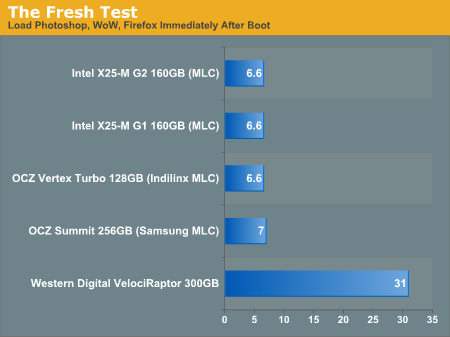
The Fresh Test, Why You Absolutely Need an SSD - The SSD Relapse
Two years ago the argument was that the technology wasn’t mature enough. Intel changed all of that with the X25-M and X25-E. Even today companies like OCZ are using Indilinx’s Barefoot controller to compete everywhere from mainstream PCs to high end servers.
PCIe cards based on SSD controllers with tons of NAND flash are the next frontier for the technology. Why deal with the current SATA bottlenecks when you can push close to a Gigabyte per second of data over some PCIe lanes?
Performance and power data aside, Gartner expects SSD sales to hit $1 billion in 2010. Like I said, sitting this one out isn’t an option.
Earlier this year Western Digital acquired SiliconSystems for $65 million and rebranded their drives. Western Digital’s true attempt at a competitive SSD won’t come until sometime next year as even the latest WD Silicon Power III isn't very competitive.
Seagate has been the quiet one, until today that is. Today Seagate is announcing that it is shipping its first SSD to OEMs. The drive is called Pulsar and this is a render of what it looks like (if it appeared in front of a star apparently):
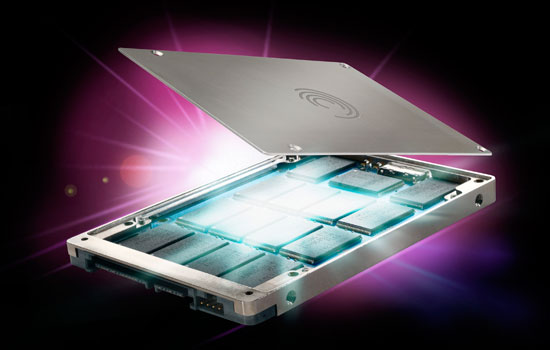
Seagate Goes Light on the Details
I will admit, I was disappointed when Seagate first approached me about Pulsar. Seagate is unwilling to discuss the manufacturer of their controller, nor are they interested in talking about any of the technology behind Pulsar. The only details we’re getting today are a handful of performance numbers, supported features, and commitment that Pulsar is shipping to OEMs.
First let’s tackle the controller question. I asked Seagate who made the controller in Pulsar and the best answer I got was that the drive uses a combination of Seagate and 3rd party IP. Translation? Someone else makes the chip, but perhaps Seagate has input into the firmware design.
Given the decades of experience Seagate has in making HDD firmware, I’m certain that some of that knowledge lends itself well to dealing with the intricacies of developing optimal SSD controller algorithms. Seagate is intimately familiar with the sorts of access patterns its customers are going to be using the most and I would be ashamed if Pulsar wasn’t heavily optimized for that.
It’s a big assumption on my part, because clearly the vast majority of players in the SSD space don’t get it right on the first try. The fact that Seagate isn’t entering the market with a splash lends me to believe that Pulsar isn’t quite perfect. Which is yet another big assumption on my part.
The controller does support idle time garbage collection similar to what both Samsung and OCZ have introduced on their drives. TRIM is also supported and enabled on the first drives.
Seagate doesn’t have an end user upgradeable firmware, but it doesn’t really matter for its first clients since Pulsar is an OEM exclusive right now. Seagate’s official stance on the issue was if you do it right the first time you don’t need to have an upgradeable firmware. Cocky, but most likely arrogance covering up the lack of a good strategy on Seagate’s part. This is something I expect to change by the time Seagate enters the consumer market.
Future Seagate SSD offerings will be available through retail channels, but Seagate wanted to address the enterprise OEM market first with Pulsar.
Pulsar uses SLC NAND, Available in 3 Sizes
Next we have the flash itself. Given the enterprise focus, Pulsar uses SLC NAND flash, putting it in a higher price, reliability and presumably performance class than the bulk of the SSDs we encounter.
There are three Pulsar models with 200GB, 100GB and 50GB of user accessible space on the drive (that's in Gigabytes, it's 186.26GiB, 93.2GiB, 46.56GiB in GibiBytes). The drives actually have 256GB, 128GB and 64GB of SLC NAND on them, the extra ~27% is used as spare area for cleaning/garbage collection/bad block allocation.
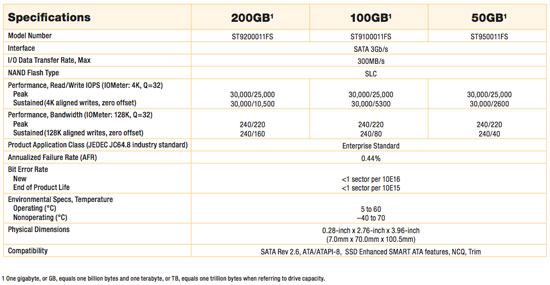
Seagate’s capacities indicate a 4 or 8-channel flash controller on the drive, compared to Intel’s 10-channel architecture (which is why Intel sticks to flash sizes that are evenly divisible by 10).
By comparison, Intel’s 64GB X25-E actually has 80GB of SLC NAND flash on the drive. Only 59.6GB is user addressable, meaning that roughly 25% of the total NAND on the X25-E is used as spare area.
The desktop 80GB X25-M has the same amount of NAND flash on the drive, but much less is dedicated as spare area. Only 6.9% of the X25-M is used for spare area.
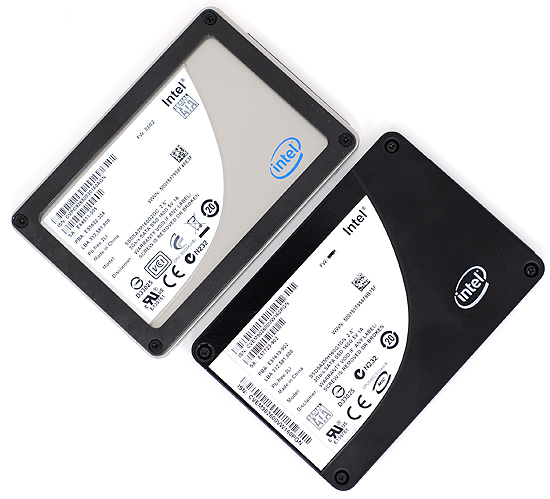
Consumer drives like the X25-M use much less spare area
There’s a direct relationship between spare area, write amplification and performance as I’ve described before. The more spare area you have, the higher your performance will be, provided you have a controller that’s smart enough to use it. The more random your workload, the more you stand to benefit from a large amount of spare area. Highly random server workloads make good use of larger spare areas and thus most enterprise SSDs allocate more NAND to spare area.
Seagate threw a jab at Intel saying that the X25’s 20GB per day for 5 years lifespan rating wasn’t useful to the end user. Instead, Seagate is classifying the Pulsar SSD as having a 5 year useful lifespan. I’ll clarify what that means in a moment.
The performance specs of the drives are below:
| IOmeter Performance, Queue Depth = 32 | 200GB | 100GB | 50GB |
| Peak Read/Write IOPS 4K 100% Random | 30,000/25,000 | 30,000/25,000 | 30,000/25,000 |
| Sustained Read/Write IOPS 4K 100% Random | 30,000/10,500 | 30,000/5300 | 30,000/2600 |
| Peak Read/Write MB/s 128KB 100% Sequential | 240/220 | 240/220 | 240/220 |
| Sustained Read/Write MB/s 128KB 100% Sequential | 240/160 | 240/80 | 240/40 |
Seagate claims that the random read/write IOPS figures are on a conditioned drive, however Seagate wouldn’t tell me how the drive was conditioned. Seagate also provides two values for each score: peak and sustained. Peak, if in a conditioned state, most likely means the highest attainable value after a short period of activity. Sustained, according to Seagate, is the absolute minimum level of performance you should expect. Both are difficult to validate without a better understanding of Seagate’s methodology, which the company was unwilling to reveal to me.
The 50GB Pulsar (effectively a 64GB drive) is good for up to 2600 4KB random write IOPS (queue depth of 32) over the entire user addressable LBA range. Intel specs the 64GB X25-E at 3300 4KB random write IOPS. Peak performance is listed at 25,000, but it’s unclear how Seagate arrived at that number. I’m guessing it refers to a clean secure erased state, in which case that’s also under what I would expect from the X25-E.
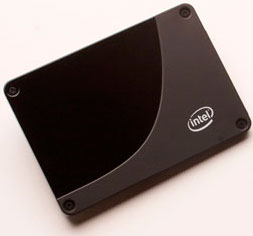
Things change completely once we get to larger capacities. The 100GB drive pulls ahead at 5300 IOPS, while the 200GB drive can deliver 10,500 IOPS. Both of these values, if they are indeed derived after continuous testing on a preconditioned drive, are higher than Intel’s X25-E. Without a drive from Seagate there’s no way to confirm, but the performance data looks promising.
Intel has avoided delivering anything larger than the 64GB X25-E, if you need capacity, Pulsar can deliver it. Even if you don’t need capacity, you could theoretically dedicate even more flash to spare area and have an even faster SSD.
Sequential read/write speed is as you’d expect. 240MB/s for sequential reads and, used, 40 - 160MB/s depending on the drive capacity. The 50GB drive’s 40MB/s sequential write speed is disappointing, but the larger sizes are palatable. Such low write speeds are either artificial or the result of the same sort of issue that continues to plague Intel’s X25-M. It’s also a way of getting you to buy the larger (read: more expensive) drives.
Lifespan: Up to 6 petabytes of Writes
Seagate is calling the Pulsar a 5 year drive. If you are absolutely dying to know how many writes you can do to the drive, there is a way of finding out.
Remember the sustained write figures from earlier? Seagate guarantees that you’ll be able to run at those sustained write rates for a period of 5 years before the drive dies.
I’ve done the math below:
| Drive | Sustained 4KB Random Write IOPS | KB Written per Second | # of Seconds in 5 Years (1825 days) | Total Writes in 5 Years |
| 200GB | 10,500 | 42000 | 157,680,000 seconds | 6167 TB |
| 100GB | 5300 | 21200 | 3113 TB | |
| 50GB | 2600 | 10400 | 1527 TB |
At 1527TB (or 1.49 petabytes) of random 4KB writes in a 5 year period, the 50GB Pulsar has a worse lifespan than Intel’s X25-E (the 64GB drive is specced at 2 petabytes of lifetime random writes).
The 200GB drive however can allegedly withstand over 6100TB (6 petabytes) of random writes before it goes to SSD heaven.
With no standardized method of testing or verifying any of these claims, we can’t do much more than take Seagate’s word for it. Given Seagate’s reputation in the industry, I’d expect that its word is worth it.
Final Words
There’s little more to say about Pulsar than what I’ve already mentioned. Seagate is finally getting in the game and, at least on paper, Pulsar appears to be in the class of Intel’s X25-E.
If Seagate can deliver on its promises, this should be good. Currently the enterprise SSD market is occupied by Intel, Samsung and a bunch of other contenders with unproven track records. Using Indilinx drives in a server environment is very tempting, but also potentially dangerous. There isn’t sufficient data out there today to say how long their drives will last under constant random writes. I tend to believe Seagate when they commit to Pulsar being a 5 year drive capable of over 6PB of random writes.
Pricing is another major unknown, but I’d expect the drives to be no cheaper than Intel’s X25-E: at least $11 per GB.
Even more exciting is the promise of consumer level SSDs from Seagate, possibly as early as 2010. Western Digital is next, whom I expect to join the race in 2010 as well. Once all of the major HDD players are in the race, we’ll see some real competition in both the high end and mainstream client SSD markets.







